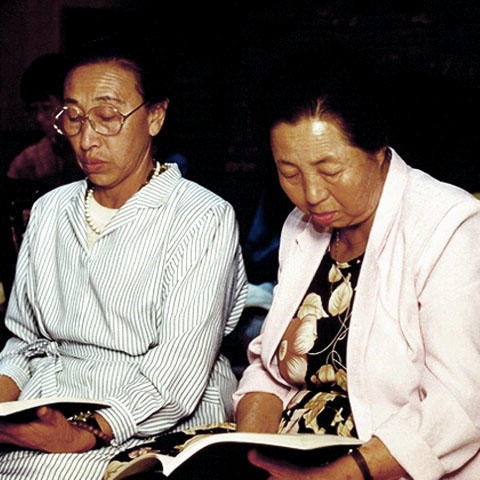
Chanting scriptures and prayers to buddhas and bodhisattvas is a central practice in all streams of Buddhism, intended both to reflect upon content and to focus the mind.
View full album
Chanting is part of the practice of most streams of the Buddhist tradition. Theravada monks and Euro-American practitioners chant portions of the Buddhist scriptures in Pali. Practitioners of the Tibetan Vajrayana tradition also chant, and some of the monks are skilled in the multi-tonal chord chanting distinctive to that tradition. In America, Korean Son practitioners chant the Heart Sutra and other scriptures in Korean and, increasingly, in English. Chanting is not so much a way of reflecting upon the content of the scriptures as it is a way of concentrating and focusing the mind.
The Pure Land traditions practice the devotional recitation of the Buddha’s name. Traditional Chinese Pure Land Buddhism emphasizes three elements of Buddhist life as being essential for rebirth in the Pure Land: faith, vows, and chanting the Buddha’s name. The Pure Land to which the faithful refer is a realm in which the Buddha Amitabha (in Chinese, Emituo Fo), literally “Infinite Light,” resides. To be reborn in the Pure Land can mean rebirth in that realm after one’s physical death, or it can mean rebirth here and now into a pure mind. Practitioners of Pure Land Buddhism have faith that chanting the name of the Buddha will bestow upon them the grace and blessing of rebirth into the Pure Land.
Today the chanting of Amitabha’s name can be heard in Pure Land Chinese temples, such as the Hsi Lai Temple in Hacienda Heights, California. There are special early morning chanting services on the first and fifteenth of the lunar month when all the monks and nuns walk slowly in serpentine procession around the Buddha Hall chanting:
NA MO E MI TUO FO
In Japanese Pure Land temples, such as those of the “True Pure Land” or Jodo Shinshu tradition, the chanting of the name of Amida is also central. The recitation is understood as an expression of gratitude for the grace of Amida Buddha. These Japanese Buddhists, whose many temples are linked together by the national Buddhist Churches of America organization, are among the earliest Buddhist immigrants to the United States, and are now in their fourth and fifth generations. In their temples in San Francisco, Portland, Chicago, or New York one will hear the recitation in Japanese:
NA MU A MI DA BUTSU
Chanting is also central to the Japanese Nichiren tradition, represented most vibrantly in the United States by the Soka Gakkai International (formerly Nichiren Shoshu of America). The many adherents of this tradition recite the name of its most sacred scripture, the Lotus Sutra (in Japanese Myoho Renge Kyo), which emphasizes the universality of Buddha nature and the unity of all Buddhist teachings. The SGI traces its roots to the Japanese monk, Nichiren (1222 – 1282 CE), who argued that it is not necessary to read and reflect on the whole of the Lotus Sutra, but that salvation is assured to those who recite but the name of this powerful scripture with reverence:
NA MU MYO HO REN GE KYO
Chanting forms the basis for both the community practice of the Nichiren Buddhists and their individual daily practice before the gohonzon, a mandala inscribed with the characters of this powerful name and enshrined on each member’s home altar.